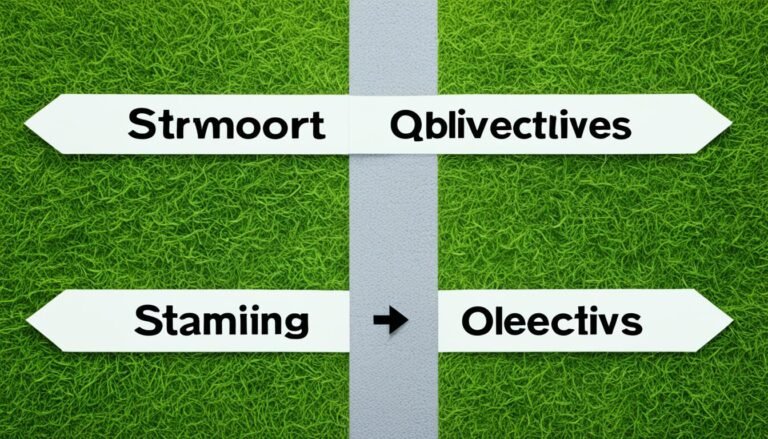How does management differ from leadership?
Did you know management and leadership are not the same? It’s true. People use these words together a lot. But, they really mean different things for a company’s success. Let’s dive into what makes them diverse and why they matter for running a business well.
Key Takeaways:
- Management and leadership are two distinct concepts with different focuses and approaches.
- Management involves implementing tasks and achieving organizational goals, while leadership inspires and motivates others towards a common vision.
- Both management and leadership play critical roles in achieving organizational success.
- Managers excel in organizing and coordinating activities, while leaders focus on aligning and influencing people.
- Leadership can emerge from anyone, regardless of their position or job title.
What is leadership?
Leadership is vital for successful groups. It goes beyond having authority. It’s about motivating others to achieve together. Let’s dive into what leadership means, its key traits, and how it influences society.
Definition of leadership
Leadership is creating positive change by using vision and influence. It’s more than job titles or personal goals. It’s the ability to help others work towards a shared vision.
Attributes of leadership
Good leaders have unique skills that help them guide and inspire their teams. These include:
- Vision: Leaders have a clear vision and share it. They give direction and purpose, aligning everyone to a common goal.
- Inspiration: They motivate others with their words and deeds. Setting high standards, they encourage the team to excel.
- Communication: Effective leaders communicate clearly and listen well. They foster open discussions within their teams.
- Empathy: They tune into their team’s needs and show they care. This creates a supportive, valued, and inclusive work environment.
Leadership as social influence
Leadership at its heart is about influencing others for positive results. Leaders use their knowledge, expertise, and personal strength to inspire and guide their teams.
The image above shows leadership as the force leading individuals and groups to their objectives.
Leadership is not about being in charge. It is about taking care of those in your charge. – Simon Sinek
Simon Sinek highlights leading as a commitment to those we lead. It’s about supporting and caring for them.
Leadership hugely impacts organizations. It helps create a great work environment, encourages innovation, and brings outstanding results. Knowing what leadership is and its essential traits is key for both future leaders and successful organizations.
What is management?
Management is about directing tasks to reach goals. It coordinates and oversees team activities. Managers guide their team, organize resources, and make sure tasks run well.
In simple words, management is reaching goals by wisely using people, time, and money. It involves planning, organizing, leading, and controlling.
Planning is key, deciding what to do and how. It’s where goals and strategies are set up. All management roles are based on this step.
Organizing arranges the workplace and delegates tasks. Its goal is to ensure everything runs smoothly. Clear roles and efficient workflows help create a positive work setting.
Leading inspires employees to meet goals. Managers are role models who guide and support their teams. Good leadership builds teamwork and trust.
Controlling means watching progress and adjusting if needed. It involves checking data and making changes to hit goals.
Management involves planning, organizing, leading, and controlling. It differs from leadership, which aims to motivate. Leaders focus on change, but managers keep daily tasks in check.
Differences between leadership and management
Leadership and management aren’t the same. They each focus on different things and use unique methods. Knowing these gaps is key for those wanting to lead or manage well. It’s also important for companies aiming to do great.
Management is about making sure things get done. It involves looking after daily tasks and making sure resources are used well. Managers are great at planning, organizing, leading, and controlling a business’s operations.
Leadership is more about painting a picture of the future. Leaders inspire people to work together toward a common goal. They guide strategic thinking and encourage innovation and change.
Here’s a quick summary of the main points:
| Leadership | Management |
|---|---|
| Focuses on setting a vision | Focuses on coordinating activities |
| Inspires and motivates others | Ensures efficient task execution |
| Long-term perspective and adaptability | Day-to-day task and process-oriented |
Strong companies need both leadership and management. Although they share some areas, it’s essential to get to know the clear differences. This way, individuals can learn what it takes to shine in their roles.
Vision and goals
Leadership and management are key for an organization’s success. Leaders set the vision and goals. Managers then work to make those plans happen.
Visionary leaders see where their group is now and where they want it to be. They pull the team together to reach that goal. They get everyone excited and working toward the same vision. Leading by example, they give the team purpose and show them the way forward.
“The best leaders are visionaries. They inspire others to see the bigger picture and work together towards a shared vision.”
Managers, however, turn vision into action. They make plans, use resources wisely, and ensure tasks are done well. Their job is to oversee the daily running of things, making sure everything is efficient.
Collaboration and Synergy
Leaders and managers need to work as a team for success. Leaders inspire and map the way to the future. Managers make sure everything runs smoothly to reach those goals.
This teamwork moves the whole organization ahead. It uses the team’s efforts wisely to reach the vision.
Comparing Leadership and Management
| Leadership | Management |
|---|---|
| Focuses on setting a vision and goals | Focuses on implementing strategies and achieving goals |
| Inspires and motivates others | Coordinates and directs activities |
| Evaluates the current state and envisions the future | Designs plans and organizes resources |
| Reduces resistance to change | Ensures efficiency and effectiveness |
| Casts a long-term perspective | Focuses on day-to-day operations |
True organizational success needs both leaders and managers. Leaders dream big, and managers make those dreams real. Their teamwork propels the company forward.

Organizing and aligning
Managers and leaders have their own crucial duties. Managers are great at organizing tasks and making sure they happen. On the other hand, leaders are all about inspiring and guiding people, aiming for a common goal. We will look at how both these roles help an organization succeed.
Managers excel at using resources well, making big goals doable, and assigning tasks. This makes the organization run smoothly. They ensure everyone is on the same page, working together properly. They do this by talking clearly and sharing the work effectively.
Leaders work to share their vision with everyone and push for future growth. They are all about getting influence. Rather than just giving tasks, they get their team to use their skills for a larger purpose. They make sure everyone sees where their job fits in and matches their work to the big vision. This gives the team a strong sense of belonging and drives them to do their best.
Managers are big on making sure everything runs well. Leaders are about inspiring everyone to work together towards a common goal. For an organization to do well, it needs both. A good mix of these two roles is key to success. By finding the right balance between organization and guiding, an organization can thrive.
| Management | Leadership |
|---|---|
| Focuses on organizing tasks and resources | Focuses on aligning individuals with a shared vision |
| Assigns work and ensures efficient execution | Inspires and influences individuals towards a common goal |
| Coordinates activities to achieve specific objectives | Guides individuals to understand their role in the bigger picture |
| Maintains order and meets short-term goals | Fosters creativity and innovation for long-term growth |
Queries and approaches
The way leaders and managers work can be very different. Leaders like to question why things are done and look into mistakes. They want to know why things happen and look to make things better. They aren’t afraid to shake things up to find new ideas, which helps their teams and companies grow.
Managers, though, are more about the everyday details of getting work done. They focus on how to meet goals and ensure everything runs well. They might not question as much as leaders, but they are key to making sure things in the company are steady and efficient.
“The only way to do great work is to love what you do. If you haven’t found it yet, keep looking. Don’t settle.” – Steve Jobs
Leadership values understanding and pushing to improve, while management is about making sure things work as they should. Having both styles is important to a company’s success. Working together, leaders and managers create an environment where new ideas and high standards thrive.
Importance of Analyzing Failures
Looking into what went wrong is a vital part of leading and managing. It teaches everyone to learn from mistakes, get better, and bounce back stronger. Leaders turn failures into chances to inspire bold moves in their teams, aiming for bigger successes.
For managers, learning from mistakes means figuring out how to avoid them in the future. This leads to smarter choices and better ways of doing things. In the end, analyzing failures helps everyone at a company grow and do their best work.
Position and quality
In the world of management, it’s key to know the gap between being in a position and your true quality. A manager has a set title in the business. But leadership doesn’t depend on a job or power.
Anybody can show leadership. It’s about what you do and say, and how you inspire others. Leaders have traits that push people to do their best. They help the whole team succeed.
“Leadership is not about being in charge. It is about taking care of those in your charge.” – Simon Sinek
In contrast, a manager uses their job’s power to make decisions. They handle things like hiring, firing, and rewarding workers. A manager keeps things organized but leadership goes beyond this role.
Leadership stands out because of personal traits like being honest, understanding, and a good communicator. It’s about sharing a vision, motivating others, and making a great work space for everyone.
The big difference between being in a position and your quality is clear. A manager relies on their job for power. True leadership comes from the qualities that make others want to follow you.
Companies need to value both managerial skills and leadership qualities. This mix of authority and inspiration is powerful. It helps the company move forward successfully.
Position vs Quality: A Comparative Overview
| Position | Quality |
|---|---|
| Derived from job title and organizational structure | Rooted in personal attributes and behaviors |
| Comes with authority and privilege | Inspires through actions and influence |
| Focuses on tasks and maintaining order | Emphasizes a shared vision and inspiring others |
| Responsible for managing and coordinating activities | Drives personal growth and motivates others |
Finding the right mix of having a position and true leadership is essential. Management brings about efficiency and order. Leadership sparks creativity, engagement, and new ideas.
Understanding this distinction helps companies build strong leaders at all levels. This empowers everyone to make a difference and meet the company’s objectives.
Conclusion
It’s key to know the difference between management and leadership for a company to succeed. Both are important but work in distinct ways. Management tackles tasks and hits specific goals. Leadership, on the other hand, inspires others towards a shared vision.
Good business knows how to mix management and leadership well. By using both the organization skill of managers and the inspirational power of leaders, companies reach their goals faster. This mix also boosts team performance.
Understanding what makes each role unique helps create a strong leadership setup. This way, companies can make better strategic choices and use their resources well. It also leads to a work setting where everyone works together, feeling empowered. By joining the strengths of both, businesses can reach their success levels.
FAQ
How does management differ from leadership?
Management is about getting tasks done and hitting goals. Leadership, however, is more about inspiring and guiding others with a shared goal in mind.
What is leadership?
Leadership involves leading by making positive changes. It uses strategy, vision, and influences to reach goals. It’s not just about titles but empowering and making smart choices.
What is management?
Management is getting planned tasks completed for organizational success. It entails planning, organizing, leading, and controlling tasks. Unlike leaders, managers more often follow set job roles focusing on achieving specific goals.
What are the differences between leadership and management?
Leadership is about setting a vision and inspiring others. Management focuses on day-to-day tasks to meet goals. Leadership looks forward, adapting over time, while management keeps things running smoothly daily.
How do vision and goals differ in leadership and management?
Leaders set visions and pathways for growth and involve the team. Managers focus on plans and organizing to reach leadership’s set goals.
How do organizing and aligning differ in leadership and management?
Managers are good at organizing tasks, resources, and breaking goals into steps. Leaders align people by showing them the big picture and encouraging growth.
What are the queries and approaches in leadership and management?
Leaders ask the tough questions and aim for improvement. They learn from failures, challenge norms, and want to change things. Managers, in contrast, focus on making plans work without shaking things up.
What is the difference between position and quality in management and leadership?
Managers hold a specific job title and have direct responsibilities. Leadership is about how you act and affect others. Managers may control who’s hired or fired, but leaders inspire people to do their best.
What is the importance of understanding the differences between management and leadership?
Knowing management and leadership’s difference is key for success. Both roles are critical but serve different purposes. Understanding and using their strengths together helps organizations thrive and motivates their people. Balanced leadership structures are vital for any successful company.








